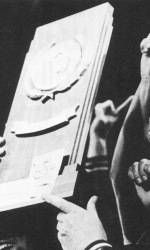
Honoring the 1982 National Champs: The Grand Illusion
April 13, 2007
Read Today’s Article in the Miami Herald
“It’ was the single most talked-about play in the history of college baseball.
`It’ set the town of Omaha buzzing for days, and the entire country tuned into college baseball as it never had before.
`It’ caused accusations that the crowd, batgirls, umpires and TV network were in collusion.
`It’ was `The Grand Illusion” a trick play devised by Miami Head Coach Ron Fraser and in the second game of the 1982 College World Series against Wichita State.
What Wichita State called it in the first few moments after its execution at Omaha’s Rosenblatt Stadium will never be repeated on these, or any other family-oriented publications’ pages.
Let’s set the stage. Miami vs. Wichita State in round two of the NCAA College World Series in Omaha, Neb. Both teams were winners of their opening games, and the victor of this contest would advance in the winner’s bracket play, while the loser would tumble into the loser’s bracket.
Wichita State was the most awesome offensive machine ever assembled in college baseball history. With a team batting average of .350, more than 100 home runs, 327 stolen bases and a 71-12 record, the Shockers were expected to challenge No. 1 ranked Texas for the title with their unique brand of running and bombardment.
Miami, conversely, wasn’t even supposed to be in the field for this eight-team, double-elimination tournament, suffering 17 regular season losses and owner of a pitching staff as maligned in 1982 as it had been praised in preceding years.
Everything came to a head on Monday , June 7, 1982.It was the sixth inning, Miami leading by the eventual winning margin of 4-3. The greatest single season base stealer in NCAA history, Phil Stephenson, 86 of 91 thefts, drew a walk to open the inning.The Play’s signal, Associate Head Coach Skip Bertman sticking his finger in his ear was given, a maneuver which pitcher Mike Kasprzak repeated to clue his teammates in. Several leisurely tosses back to first base got the desired result, Stephenson diving back.
Once more Kasprzak stepped off the rubber, but this time he kept the ball and faked the throw to first. First baseman Steve Lusby dove over the returning runner, cursed his displeasure and took off for the right field bullpen in pursuit of a ball, or so it seemed.
Second baseman Mitch Seoane and right fielder Mickey Williams did likewise, converging on the bullpen where reliever Dan Smith and catcher Bob Walker leaped up as if to avoid being hit by a ball.Shortstop Bill Wrona forlornly covered second base, looking in the distance at the bullpen commotion. Kasprzak shrugged his shoulders as if he had indeed thrown the ball away. And all the while, half the Miami dugout was stirring and pointing to the bullpen area, admonishing, “there’s the ball.”
First base umpire Dale Williams started down the line; the entire right field bleachers rose as one to see the commotion going on in front of it; obviously, the ball was loose.
In short it was one heck of a fake.
Stephenson fell for the ploy and lit out for second base. Kasprzak calmly pulled the ball from his mitt and tossed to Wrona, who put the tag on a very confused runner.
From that point, the momentum shifted Miami’s way. Wichita State no longer in this game or the succeeding Championship Game, used reckless abandon on the base paths. In Miami’s very next game, a superior running team, Texas, was so wary they shortened their leads by a step or two.And in the semifinal, Miami pitcher Rob Souza muffed a pickoff play at second, throwing the ball into center field. But the Maine runner stayed put. As his coach, Dr. John Winkin, put it, “I thought it was another trick play. I thought Souza had thrown the rosing bag into center and still held the ball.”
“That’s the best,” said Bertman. “But that’s what a trick play will do for you, place uncertainty in the mind of the opponent.”For the play to have worked, certain factors had to be present:- Wichita State had to use a player as first base coach- Stephenson or one of Wichita State’s other aggressive baserunners, Loren Hibbs (63 steals) or Jim Thomas (57) had to be on base- It had to be late in the game – dusk- The runner had to dive back to the bag on the initial toss over.
“I thought if we could put those four things together, we’d have a shot,” said Bertman, who at assistant coach Dave Scott’s urging, put the play in “to loosen the team up” the day before.
“The players really enjoyed practicing the play,” Bertman added, “and that’s what really sold me on it.”
The play actually was on in both the first and third innings, but circumstances prevented it from being attempted. The time came in the sixth, when all factors meshed perfectly. History was made, in front of 10,280 in-person witnesses, millions more on live nationwide cable TV and, in days to come, tens of millions more on such shows as “This Week in Baseball,” “The Baseball Bunch,” and virtually every sportscast in the land.
In short, Miami had done for college baseball with one trick play, what no one previously could; bring national acclaim.Was there any downside to the play?
“Do you know how stupid I would have looked if it hadn’t worked?” asked Fraser.
For Fraser, for the University of Miami and for the good of college baseball, fortunately, it worked.






